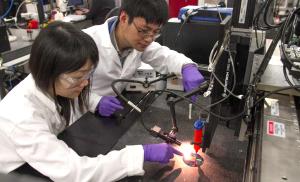LAB REPORT
Science and Technology Making Headlines
Feb. 12, 2016


Melting glaciers, like the Equp Sermia glacier in West Greenland, are contributing to sea level rise, one of the most noticeable effects of global warming. Image courtesy of Michele Koppes, University of British Columbia.
Thousands and thousands of years
The Earth may suffer irreversible damage that could last tens of thousands of years because of the rate humans are emitting carbon into the atmosphere.
In a new study, researchers at Oregon State University, Lawrence Livermore National Laboratory and collaborating institutions found that the longer-term impacts of climate change go well past the 21st century.
LLNL’s Benjamin Santer said the focus on climate change at the end of the 21st century needs to be shifted toward a much longer-term perspective. “Our greenhouse gas emissions today produce climate-change commitments for many centuries to come,” HEsaid. “Today’s actions — or inaction — will have long-term climate consequences for generations of our descendants.”

Lawrence Livermore and Autodesk researchers are working on new football helmet pads that will dissipate energy more effectively.
Moving a-head
It’s hard to ignore the head injuries involved in football. In the last few years, there has been an exponential rise in players affected by concussions. How do you build a better helmet to prevent such injuries?
In comes 3D printing, the new way to make just about anything. Metal 3D printing in particular has been on the rise lately and as researchers find new ways to bring it down in scale, it’s becoming a much more flexible alternative to traditional materials.
An ongoing research project between the Lawrence Livermore National Laboratory and Autodesk Research is putting the emphasis on this process as a way to revolutionize the sports equipment industry. LLNL, which has a team of research engineers dedicated to additive manufacturing and metal 3D printing, is working with Autodesk Research to develop complex material microstructures that will dissipate energy more effectively than current helmet pads.


LLNL material and biomedical scientist Fang Qian (left) and engineer Cheng Zhu demonstrate a direct ink writing 3D printer they used to manufacture supercapacitors out of a graphene-based aerogel. Photo by Julie Russell/LLNL
Better electronics through 3D printing
Smartphones, wearables, implantable devices, electric cars and wireless sensors could get a boost through a material dubbed “frozen smoke.”
For the first time ever, scientists at Lawrence Livermore and UC Santa Cruz have successfully 3D-printed supercapacitors using an ultra-lightweight graphene aerogel, also known as frozen smoke.
Using a 3D-printing process called direct-ink writing and a graphene-oxide composite ink designed at the Lab, the LLNL team was able to print micro-architected electrodes and build supercapacitors able to retain energy on par with those made with electrodes 10 to 100 times thinner.
“This breaks through the limitations of what 2D manufacturing can do,” said engineer Cheng Zhu. “We can fabricate a large range of 3D architectures. In a phone (for instance) you would only need to leave a small area for energy storage. The geometry can be very complex.”


The British survey ship HMS Challenger blazed an oceanic trail a century and a half ago and collected valuable ocean temperature data. Image: William Frederick Mitchell via Wikimedia Commons
Deep sea getting hot, hot, hot
Ocean temperatures first collected during one of the great 19th-century voyages of exploration confirm one of the consequences of climate change: humans have managed to warm even the deepest parts of the ocean.
A new Lawrence Livermore study calculates that the amount of heat absorbed by the ocean has doubled in the last 18 years. A third of this heat has collected in the depths at least 700 meters below the waves − and the same region is rapidly getting hotter.
Peter Gleckler, a research scientist at LLNL, and colleagues started with data collected by the world’s first modern oceanographers aboard the British survey ship HMS Challenger in 1872-76. The team then used climate simulations, historical measurements and readings from autonomous floats to compare the changes in the ocean temperatures over the historical era.


A new energy system developed by LLNL researchers and colleagues would tap geothermal energy.
Tapping the energy down under
Researchers from Lawrence Livermore, Ohio State University, the University of Minnesota and TerraCOH Inc. have designed a system that they say can store renewable energy and sequester carbon.
The system would tap geothermal energy, store energy from above-ground sources and dispatch it to the grid throughout the year like an underground battery, while at the same time storing CO2 from fossil-fuel power plants.
“If you want to store the large quantities of renewable energy necessary to balance seasonal supply-demand mismatches —and store [them] efficiently — we believe the best way to do that is underground,” says Thomas Buscheck, leader of LLNL’s Geochemical, Hydrological and Environmental Sciences Group.





